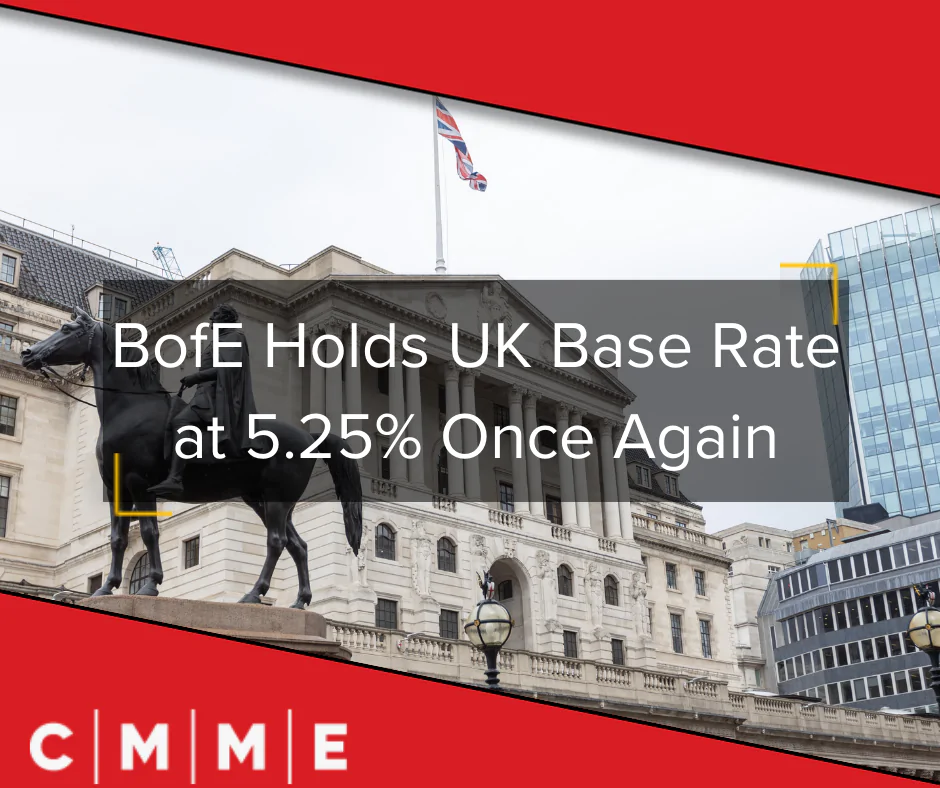
March 21st, 2024
Surprise surprise, the UK base rate is maintained at 5.25%, echoing February’s decision. CMME mortgage seekers are keenly attuned to the implications of this stance. This marks the eighth consecutive month of maintaining this figure, further connoting the economic stability communicated via previous announcements.
For close observers of economic trends, this decision may not come as a complete surprise. Since August 2023, the base rate has remained unaltered, reflecting the Bank of England’s strategic approach in balancing economic recovery with inflationary pressures.
Nothing New Here…
As per previous announcements, this stability enables borrowers to plan their finances with confidence, knowing that their mortgage repayments remain unaffected by sudden shifts in interest rates.
By keeping borrowing costs stable, the BofE aims to temper excessive spending, thereby curbing inflationary trends. This measured approach is designed to support sustainable economic growth while averting the risks associated with runaway inflation.
Future Forecasts:
Economic experts struggle to give concrete predictions of the direction in which the base rate will go. However, Reuters claim that investors are better on rate cuts to be announced before the end of the year. There is plenty of opportunity for rate cuts throughout the remainder of 2024, with the remaining MPC announcement dates as follows:
9th May 2024
20th June 2024
1st August 2024
19th September 2024
7th November 2024
19th December 2024
How the base rate works:
The base rate in the UK, also known as the Bank Rate, is the interest rate set by the Bank of England’s Monetary Policy Committee (MPC). It’s a pivotal tool used by the Bank of England for managing the country’s monetary policy, primarily to control inflation and stabilize the economy. Here’s a breakdown of how it works and its impacts:
Purpose of the Base Rate:
- Control Inflation: The primary goal is to keep inflation close to the Bank of England’s target of 2%. Inflation represents the rate at which the prices of goods and services rise, decreasing purchasing power over time. By adjusting the base rate, the Bank of England aims to control economic overheating or stimulate growth as necessary.
- Economic Stability: Through managing inflation, the base rate helps in maintaining economic stability, ensuring a stable environment for investment, spending, and saving.
How It Works:
- Influencing Borrowing and Spending: When the Bank of England increases the base rate, borrowing costs for banks rise. In turn, banks increase the interest rates they charge on loans and mortgages. This makes borrowing more expensive for consumers and businesses, which tends to reduce spending and borrowing, cooling down an overheated economy.
- Encouraging Saving: Conversely, a higher base rate makes saving more attractive, as the returns on savings accounts and other fixed-income investments typically increase. This further helps in reducing excessive spending by encouraging people to save more.
- Stimulating the Economy: If the economy is sluggish, the Bank of England might lower the base rate to make borrowing cheaper. This encourages more spending and investment by businesses and consumers, aiming to stimulate economic growth.
Impact on Inflation:
Balancing Act: The Bank of England uses changes in the base rate as a tool to keep inflation around its target level. If inflation is too high, increasing the base rate can help cool down the economy. If inflation is too low, decreasing the rate can help to stimulate economic activity.
Recent Trends:
The Bank of England adjusts the base rate in response to various economic indicators and forecasts. For example, if there’s a significant rise in inflation, as witnessed at the end of 2021 leading into 2022, the Bank may start to increase the base rate to counteract these pressures. The goal is always to balance economic growth with stable prices for consumers.
Effect on Mortgages, Loans, and Savings:
- Mortgages and Loans: Typically, when the base rate rises, so do the interest rates on mortgages and loans. This means higher monthly payments for those with variable or tracker mortgages.
- Savings: Higher base rates usually result in better returns on savings accounts, as banks offer higher interest rates to savers.
In summary, the base rate in the UK is a critical tool for the Bank of England, aimed at managing inflation and maintaining economic stability. Its adjustments have wide-reaching implications, influencing everything from mortgage rates to the cost of borrowing and the attractiveness of saving.
CMME’s Commitment to Finding You the Best Deal:
As your property journey unfolds, CMME remains a trusted partner for those seeking clarity and confidence in their mortgage decisions.
No matter your personal situation we will find you a mortgage made to measure!
The Bank of England’s decision to maintain the UK base rate at 5.25% may sound like a broken record, however it conveys a message of market stability to anyone looking to secure a mortgage going into the Spring.
At CMME Mortgages, we stand ready to support our clients every step of the way, ensuring that their mortgage journey is guided by expertise, integrity, and unwavering dedication to their financial well-being.



